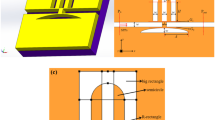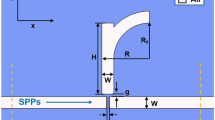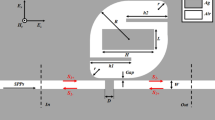Abstract
The sensitivity of plasma devices in pressure sensing has been undergoing significant advancements. However, the quantitative relationship between the actual deformation of the structure and the resulting optical transmission characteristics has not yet been investigated in depth. In this study, we propose a novel metal–insulator-metal (MIM) waveguide structure that exhibits a distinct transmission spectrum featuring a sharp Fano line. Notably, the incorporation of a baffle into the resonator induces the formation of a double Fano resonance, which occurs irrespective of the presence of external pressure. Remarkably, the second Fano resonance (FR2), effectively enhances the refractive index sensitivity of the system from 1400 nm/RIU to 1600 nm/RIU when the baffle is integrated into the pressure-free resonator. Furthermore, the introduction of a baffle into the pressurized cavity significantly improves the pressure sensitivity of the system. Specifically, the first Fano resonance (FR1) increases the pressure sensitivity from 2.40 nm/MPa to 6.88 nm/MPa, making it a multifunctional plasma device that functions as both an optical pressure sensor and a refractive index sensor.





Similar content being viewed by others
Data Availability
Data underlying the results presented in this paper are not publicly available at this time but may be obtained from the authors upon reasonable request.
References
Verellen N, Sonnefraud Y, Sobhani H, Hao F, Moshchalkov VV, Dorpe PV, Nordlander P, Maier SA (2009) Fano resonances in individual coherent plasmonic nanocavities. Nano Lett 9(4):1663–1667
Pang S, Huo Y, Xie Y, Hao L (2016) Fano resonance in MIM waveguide structure with oblique rectangular cavity and its application in sensor. Opt Commun 381:409–413
Wang S, Yu S, Zhao T, Wang Y, Shi X (2020) A nanosensor with ultra-high FOM based on tunable malleable multiple Fano resonances in a waveguide coupled isosceles triangular resonator. Opt Commun 465:125614
Yang Q, Liu X, Guo F, Bai H, Zhang B, Li X, Tan Y, Zhang Z (2020) Multiple Fano resonance in MIM waveguide system with cross-shaped cavity. Optik 220:165163
Hu F, Yi H, Zhou Z (2011) Wavelength demultiplexing structure based on arrayed plasmonic slot cavities. Opt Lett 36(8):1500
Liu X, Li J, Chen J, Rohimah S, Tian H, Wang J (2021) Independently tunable triple Fano resonances based on MIM waveguide structure with a semi-ring cavity and its sensing characteristics. Opt Express 29(13):20829
Rashid KS, Tathfif I, Yaseer AA, Hassan MdF, Sagor RH (2021) Cog-shaped refractive index sensor embedded with gold nanorods for temperature sensing of multiple analytes. Opt Express 29(23):37541
Zhu J, Li N (2020) MIM waveguide structure consisting of a semicircular resonant cavity coupled with a key-shaped resonant cavity. Opt Express 28(14):19978
Wang M, Tian H, Liu X, Li J, Liu Y (2022) Multiparameter sensing based on tunable Fano resonances in MIM waveguide structure with square-ring and triangular cavities. Photonics 9(5):291
Zhang J, Wang X, Zhu J, Chen T, Zhang L, Yang H, Tang C, Qi Y, Yu J (2023) Metal–insulator–metal waveguide structure coupled with T-type and ring resonators for independent and tunable multiple Fano resonance and refractive index sensing. Opt Commun 528:128993
Fang Y, Wen K, Li Z, Wu B, Chen L, Zhou J, Zhou D (2019) Multiple Fano resonances based on end-coupled semi-ring rectangular resonator. IEEE Photonics J 11(4):1–8
Butt MA (2020) Numerical investigation of a small footprint plasmonic Bragg grating structure with a high extinction ratio. Photon Lett PL 12(3):82
Fang Y, Sun M (2015) Nanoplasmonic waveguides: towards applications in integrated nanophotonic circuits. Light Sci Appl 4(6):e294–e294
Wang J, Feng H, Zhang J, Liu C, Zhang Z, Fang D, Wang L, Gao Y (2022) Plasmonic band-stop MIM waveguide filter based on bilateral asymmetric equilateral triangular ring. Optik 265:169535
Phua WK, Akimov Y, Wu L, Chu HS, Bai P, Danner A (2016) Highly efficient tunable and localized on-chip electrical plasmon source using protruded metal-insulator-metal structure. Opt Express 24(10):10663
Qi K, Zhu Y, Sun H, Yu Y (2017) Metallic planar lens constructed by double-turn waveguides for sub-diffraction-limit focusing. Opt Express 25(18):21191
Chen F, Yao D (2016) Realizing of plasmon Fano resonance with a metal nanowall moving along MIM waveguide. Opt Commun 369:72–78
Khonina SN, Kazanskiy NL, Butt MA, Kaźmierczak A, Piramidowicz R (2021) Plasmonic sensor based on metal-insulator-metal waveguide square ring cavity filled with functional material for the detection of CO 2 gas. Opt Express 29(11):16584
Al Mahmud R, Faruque MO, Sagor RH (2021) A highly sensitive plasmonic refractive index sensor based on triangular resonator. Opt Commun 483:126634
Khani S, Hayati M (2021) An ultra-high sensitive plasmonic refractive index sensor using an elliptical resonator and MIM waveguide. Superlattices Microstruct 156:106970
Chen L, Liu Y, Yu Z, Wu D, Ma R, Zhang Y, Ye H (2016) Numerical analysis of a near-infrared plasmonic refractive index sensor with high figure of merit based on a fillet cavity. Opt Express 24(9):9975
Chen Z, Ma X, Duan Y, Li L, Zhang S, Wang Y, Yu Y, Hou Z (2023) Tunable electromagnetically induced absorption based on coupled-resonators in a compact plasmonic system. Opt Express 31(22):35697
Rohimah S, Tian H, Wang J, Chen J, Li J, Liu X, Cui J, Xu Q, Hao Y (2022) Fano resonance in the plasmonic structure of MIM waveguide with r-shaped resonator for refractive index sensor. Plasmonics 17(4):1681–1689
Palizvan P, Olyaee S, Seifouri M (2018) An optical MIM pressure sensor based on a double square ring resonator. Photonic Sens 8(3):242–247
Tathfif I, Yaseer AA, Rashid KS, Sagor RH (2021) Metal-insulator-metal waveguide-based optical pressure sensor embedded with arrays of silver nanorods. Opt Express 29(20):32365
Chen F, Yang WX (2022) Pressure sensor based on multiple Fano resonance in metal–insulator–metal waveguide coupled resonator structure. J Opt Soc Am B 39(7):1716
Wu J, Lang P, Chen X, Zhang R (2016) A novel optical pressure sensor based on surface plasmon polariton resonator. J Mod Opt 63(3):219–223
Johnson PB, Christy RW (1972) Optical constants of the noble metals. Phys Rev B 6(12):4370–4379
Chai Z, Hu X, Zhu Y, Sun S, Yang H, Gong Q (2014) Ultracompact chip-integrated electromagnetically induced transparency in a single plasmonic composite nanocavity. Advanced Optical Materials 2(4):320–325
Chai Z, Hu X, Yang H, Gong Q (2017) Chip-integrated all-optical diode based on nonlinear plasmonic nanocavities covered with multicomponent nanocomposite. Nanophotonics 6(1):329–339
Qiao L, Zhang G, Wang Z, Fan G, Yan Y (2019) Study on the Fano resonance of coupling M-type cavity based on surface plasmon polaritons. Opt Commun 433:144–149
Alt H, Von Brentano P, Gräf H-D, Hofferbert R, Philipp M, Rehfeld H, Richter A, Schardt P (1996) Precision test of the Breit-Wigner formula on resonances in a superconducting microwave cavity. Phys Lett B 366(1–4):7–12
Zhao T, Yu S (2018) Ultra-High sensitivity nanosensor based on multiple Fano resonance in the MIM coupled plasmonic resonator. Plasmonics 13(4):1115–1120
Miyata M, Holsteen A, Nagasaki Y, Brongersma ML, Takahara J (2015) Gap plasmon resonance in a suspended plasmonic nanowire coupled to a metallic substrate. Nano Lett 15(8):5609–5616
Funding
Fundamental Research Funds for the Central Universities (buctrc202143), the Program of State Key Laboratory of Quantum Optics and Quantum Optics Devices (No. KF202202), the National Natural Science Foundation of China (NSFC) (Grant No. 62175010, 12174037, 11974225, 12204030).
Author information
Authors and Affiliations
Contributions
M.X. wrote the main manuscript text and C.Z. examined the manuscript. W.Y and L.T. prepared figures 1-3. All authors reviewed the manuscript.
Corresponding author
Ethics declarations
Competing Interests
The authors declare no competing interests.
Additional information
Publisher's Note
Springer Nature remains neutral with regard to jurisdictional claims in published maps and institutional affiliations.
Appendix
Appendix
As shown in Fig. 6, when a baffle with width a = 100 nm and height b = 100 nm-200 nm is added, the transmission spectrum generated by the system still maintains the combination pattern of Lorentz peak and Fano peak. The bottom of the baffle is confined to the top of the waveguide, and with the increase of the height b value to 300 nm, the Lorentz peak causes splitting, and the energy in the resonator moves and is redistributed.
Rights and permissions
Springer Nature or its licensor (e.g. a society or other partner) holds exclusive rights to this article under a publishing agreement with the author(s) or other rightsholder(s); author self-archiving of the accepted manuscript version of this article is solely governed by the terms of such publishing agreement and applicable law.
About this article
Cite this article
Ma, X., Li, T., Wang, Y. et al. Baffle Induced Sensing Enhancement for Pressure and Refractive Index Based on Fano Resonance. Plasmonics (2024). https://doi.org/10.1007/s11468-024-02262-z
Received:
Accepted:
Published:
DOI: https://doi.org/10.1007/s11468-024-02262-z





